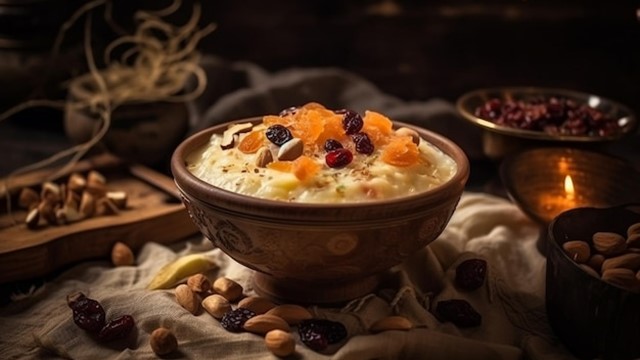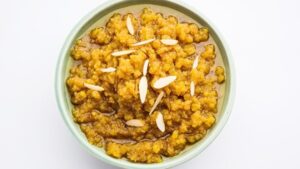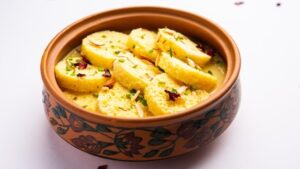Rabri, also known as Rabdi, is a traditional Indian sweet delicacy that originates from the Indian subcontinent. It is a rich and creamy dessert made by reducing milk over low heat until it thickens, resulting in a luscious, granular-textured, and flavorful dairy-based dessert.
Culinary Significance:
The culinary significance of Rabri within Indian cuisine encompasses several aspects that highlight its importance and appeal:
Traditional Heritage:
Culinary Legacy:
- Rich Tradition: Rabri reflects the culinary heritage of Indian sweets, showcasing centuries-old methods of milk reduction and flavor enhancement.
Historical Roots:
- Historical Significance: Its preparation methods have been passed down through generations, maintaining cultural connections and traditional cooking techniques.
Festive and Celebratory Importance:
Festive Treats:
- Festival Staple: Rabri is a quintessential dessert served during festivals like Diwali, Holi, Raksha Bandhan, and weddings, signifying richness and celebration.
Symbolism:
- Auspicious Offering: Offered as Prasad (sacred offering) in temples during religious ceremonies, representing devotion and auspiciousness.
Culinary Craftsmanship:
Cooking Expertise:
- Skillful Preparation: Making Rabri demands expertise in continuously simmering and stirring milk over low heat for an extended period, showcasing culinary skill.
Milk Transformation:
- Milk Alchemy: The slow reduction of milk into a rich, creamy texture exemplifies the transformation of basic ingredients into an exquisite dessert.
Luxurious Dessert Experience:
Indulgent Delight:
- Opulence in Taste: Rabri’s creamy texture and sweetness provide a luxurious dessert experience, appreciated for its velvety richness.
Festive Symbol:
- Celebration of Sweetness: Its richness symbolizes joy, prosperity, and the sweetness of life, marking celebratory moments and social gatherings.
Cultural Representation:
Regional Varieties:
- Regional Flavors: Different regions in India have their variations of Rabri, adding unique local ingredients or flavors, showcasing diverse culinary customs.
Shared Traditions:
- Culinary Unity: Rabri serves as a unifying dessert, enjoyed across communities, transcending regional boundaries, and fostering cultural unity.
Art of Presentation:
Serving Traditions:
- Presentation Styles: Rabri is elegantly served in bowls or earthenware, garnished with nuts, saffron, or edible silver leaf, enhancing its visual appeal.
Pairing and Complements:
- Accompaniments: Often served with sweets like jalebi, malpua, or enjoyed on its own, highlighting its versatility in taste pairings.
Rabri’s culinary significance lies not only in its decadent taste but also in its cultural connections, representing tradition, festivity, culinary expertise, and the celebration of sweetness ingrained within Indian heritage and festive occasions.
Cultural Heritage:
Rabri holds a significant place in the cultural heritage of India, embodying traditions, culinary craftsmanship, and a rich historical legacy:
Traditional Culinary Craftsmanship:
Time-Honored Techniques:
- Ancient Origins: The preparation methods for Rabri have been passed down through generations, showcasing ancient culinary techniques of slow milk reduction.
Art of Milk Transformation:
- Milk Alchemy: The slow cooking and stirring of milk for hours result in the transformation of basic ingredients into a delectable dessert, highlighting culinary expertise.
Festive and Ceremonial Significance:
Festive Celebrations:
- Festivity Emblem: Served during festivals like Diwali, Raksha Bandhan, or weddings, symbolizing joy, prosperity, and the sweetness of auspicious occasions.
Ritual Offerings:
- Sacred Connotations: Presented as Prasad in temples during religious ceremonies, signifying devotion, blessings, and the sanctity of cultural practices.
Culinary Traditions and Heritage:
Regional Variations:
- Diverse Influences: Different regions across India boast their versions of Rabri, adding regional ingredients and flavors, showcasing the country’s culinary diversity.
Generational Handing Down:
- Heritage Preservation: Recipes for Rabri are often handed down through generations, preserving cultural legacies and familial culinary traditions.
Symbol of Culinary Unity:
Culinary Harmony:
- Cultural Unifier: Enjoyed across diverse communities, Rabri serves as a unifying dessert, transcending regional boundaries, and fostering culinary harmony.
Shared Culinary Heritage:
- Common Thread: Its popularity and widespread appeal create a shared sense of cultural identity, reflecting a collective appreciation for traditional Indian sweets.
Culinary Evolution and Adaptation:
Continual Relevance:
- Timeless Appeal: Despite evolving tastes and culinary innovations, Rabri retains its timeless charm, continuing to be cherished and relished across generations.
Fusion and Creativity:
- Adaptability: Rabri’s adaptability to fusion desserts or modern adaptations showcases its resilience in blending tradition with contemporary culinary trends.
Commemoration of Cultural Roots:
Embracing Heritage:
- Cultural Emblem: Rabri represents a deep-rooted culinary heritage, commemorating the essence of traditional Indian sweets in the country’s cultural tapestry.
Rabri, as a revered dessert, stands as a testament to India’s rich cultural heritage, bridging traditions, celebrations, and culinary craftsmanship, while being a cherished part of festivals, rituals, and family gatherings for generations.
Continuity and Evolution:
The evolution and continuity of Rabri as a dessert within Indian cuisine reflect its ability to adapt to changing times while preserving its traditional essence:
Timeless Relevance:
Culinary Timelessness:
- Enduring Charm: Rabri’s enduring popularity spans generations, maintaining its significance as a beloved dessert over centuries.
Consistent Favoritism:
- Continual Admiration: Its rich taste and cultural connections ensure its continual favoritism, cherished across diverse demographics and age groups.
Culinary Adaptability:
Fusion and Innovation:
- Adapting to Modern Tastes: Rabri remains relevant by embracing contemporary culinary trends, featuring in fusion desserts or innovative adaptations.
Creative Culinary Explorations:
- Inventive Variations: Home chefs and professional cooks experiment with Rabri recipes, infusing new flavors or incorporating it into diverse culinary creations.
Cultural Preservation:
Heritage Conservation:
- Preserving Tradition: Despite evolving tastes, Rabri upholds its traditional preparation methods, safeguarding cultural practices and culinary heritage.
Generational Handing Down:
- Continued Legacy: Recipes for Rabri are passed down through generations, ensuring its perpetuation and cultural significance within families.
Modern Interpretations:
Culinary Modernization:
- Adaptation to Preferences: Variations cater to contemporary tastes, offering healthier versions or incorporating unique ingredients without losing its essence.
Fusion with Contemporary Desserts:
- Culinary Blend: Rabri seamlessly integrates into modern desserts, blending its classic richness with trendy dessert forms for a fusion culinary experience.
Symbol of Culinary Evolution:
Time-Tested Tradition:
- Adaptive Resilience: Rabri’s ability to adapt while retaining its traditional flavors exemplifies its resilience and adaptability within culinary evolution.
Culinary Resonance:
- Continued Appeal: Despite modern dessert options, Rabri’s continued appreciation signifies its unwavering appeal and resonance with dessert enthusiasts.
Cultural and Culinary Continuation:
Emotional and Social Connection:
- Communal Significance: Rabri’s presence during festivities and gatherings continues to unite families and communities, marking special occasions with its sweetness.
Culinary Continuum:
- Unbroken Tradition: Its continual preparation and serving across generations ensure its place as an integral part of Indian sweet traditions.
Rabri’s evolution manifests through its adaptability to contemporary tastes while honoring its enduring heritage, ensuring its place as a cherished dessert that seamlessly blends tradition with modernity within the rich tapestry of Indian culinary delights.
Recipe
Here’s a traditional recipe for making Rabri:
Ingredients:
- 1 liter full-fat milk
- 1/2 cup sugar (adjust to taste)
- 1/2 teaspoon cardamom powder
- A pinch of saffron strands (optional)
- Chopped nuts (almonds, pistachios) for garnish
Instructions:
- Preparation:
- Pour the milk into a heavy-bottomed, wide pan or kadhai.
- Boil the Milk:
- Place the pan on medium heat and bring the milk to a boil while stirring occasionally to prevent it from sticking to the bottom.
- Simmering Process:
- Once the milk starts boiling, reduce the heat to low-medium and let it simmer. Stir the milk intermittently to avoid forming a cream layer on top.
- Milk Reduction:
- Allow the milk to simmer and reduce gradually. As it reduces, a creamy layer will form on the surface. Gently push this creamy layer back into the milk while stirring.
- Sugar Addition:
- After about 30 minutes of simmering and reducing, add sugar to the milk. Stir well to dissolve the sugar.
- Flavor Enhancement:
- Add cardamom powder and saffron strands (if using) to the milk and continue simmering.
- Thickening Process:
- Keep simmering the milk on low heat until it reduces to about one-third or reaches a thick, creamy consistency. This might take around 1.5 to 2 hours.
- Garnishing:
- Once the Rabri thickens to your desired consistency, turn off the heat. Let it cool slightly.
- Garnish the Rabri with chopped nuts like almonds and pistachios.
- Serving:
- Serve Rabri warm or chilled, as preferred.
Enjoy the Creamy Deliciousness of Homemade Rabri!
This traditional Rabri recipe results in a rich, creamy dessert with a grainy texture, accentuated by the aromatic flavors of cardamom and saffron. Adjust the sweetness and garnishes according to your taste preferences for a delightful indulgence in this classic Indian sweet.




